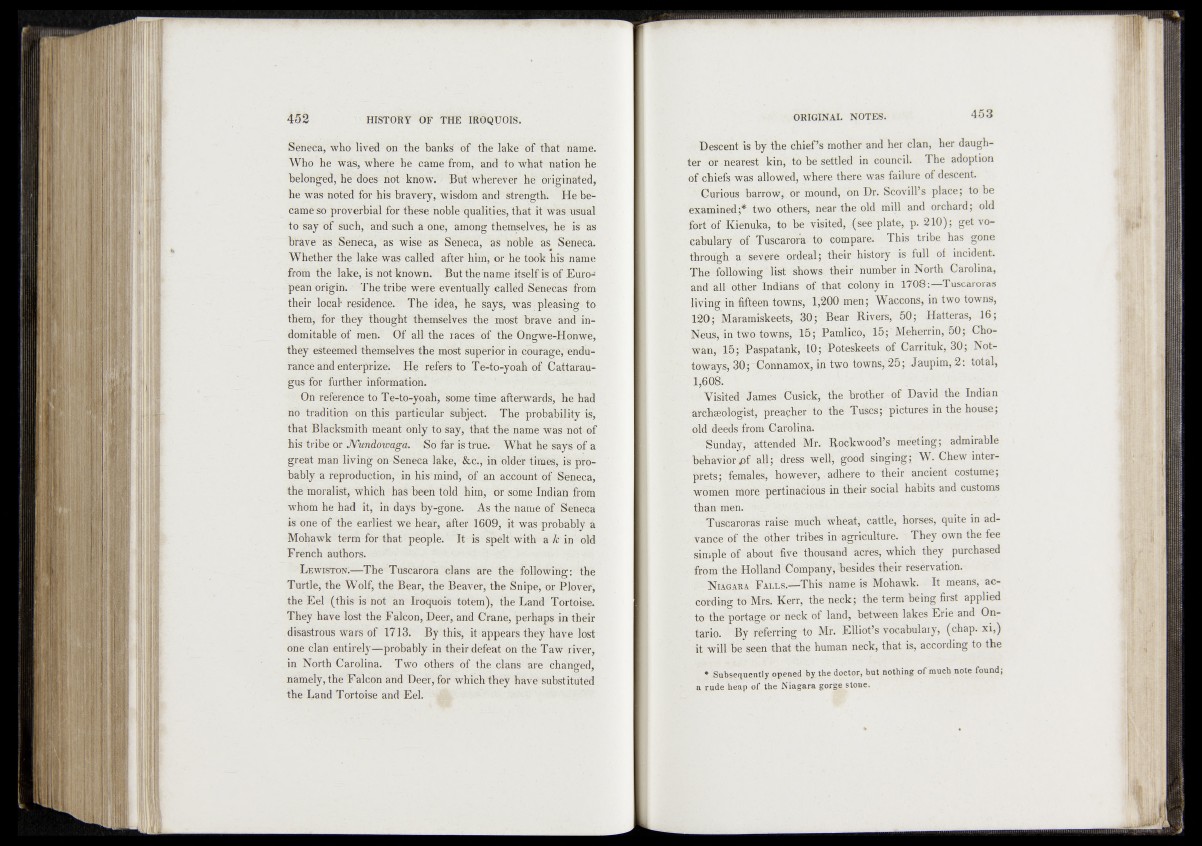
Seneca, who lived on the banks' of the lake of tMt name.
Who he was, where he came frbm, and to What nation he
belonged, hq does not know. - But whereVer hOOriginated,
he was noted for his bravery, wisdom and stffength*. He became
so proverbial for these noble 'qualities, "that it was usual
to say of such, and such a ofa#j among themselves,-/he' is as
btave as. Senbca, 'as Wiseis Seneca, as noble as Seneca.
Whether the lake-was called after hint, bt he took hfs name
from the lake, is notknoWn. But the name ftseTfiS’ of Euro«
pean origin.* The tribe were eventually Grilled Senecas from
their looal' residence.’ The idea, he hay’s,’ was pleasing- to
them, fdr they thought themselves the' most brave and indomitable
of men/ Of all the racesi of the Qngwe-Honwe,
they esteemed themselves the most Superior in courage/endurance
and enterprise: lie refers to Te-to-yoah of Cattaraugus
for further information. ; :
On reference to Te-to-yoah, some time-afterwards, .he had
no traditl'oir -On this particular 'sufejectt The probability is,
that Blacksmith meant only to say, that, the name whs not. ®f
his tribe or JVimdcPwaga. So far is true.' What he says’of a
great man living on Seneca lake,-&c., in older timesr.is probably
a reproduction, in his'mind, an account of- Seneca,
the moralist, which has been told him, Of some Indian from
whom he had it, in- days' by-gone. As the name o f Seneca
is one of the earliest we heats after 1609, it was probably a
Mohawk term for that people. It is spelt’with a k in old
French authors.
Lewiston:—The Tuscarora clans are the following: the
Turtle, the Wolf, the Bear, the Beaver, the Snipe, or Plover,
the Eel (this is not an Iroquois totem), the Land Tortoise.
They have l&st the Falcon, Deer, and Crane, perhaps in their
disastrous wars of 1713. By this, it appears they have lost
one clan entirely—probably in their defeat on the Taw river,
in North Carolina. Two others of the clans are changed,
namely, the Falcon and Deer, for which they have substituted
the Land Tortoise and Eel. *
Descent is by the chief's mother and her clan, her daughter
hf -nearest kin, to be settled in council. The adoption
of chiefs was allowed, where there was failure of descent.
Curious barrow, or mbripd, on Dr. Scovill’s place; to be
examined;* two others, near the old mill and orchard; old
fort of Kienuka, to be visited, (see plate, p. 210); get vocabulary
of Tuscarora to compare. This tribe has gone
through a' severe ordeal; their history is full of incident.
The following list shows their number in North Carolina,
and all other Indians of that colony in 1708:—Tuscaroras
living in fifteen towns,' 1,200 men; Waccons, in two towns,
120; Maramiskeets, 30; Bear Rivers, 50; Hatteras, 16;
Neus, in two towns, 15; Pamlico, 15^Meherrin, 50; Chowan,.
15; Paspatank,TO; -Poteskeets.-of Carrituk, 30; Notts
ways,'30; Conhamox, in two towns, 2 5 ;,Jaupim, 2: total,
1,60$ 1
V is ite d 'James, Cusick, the brother of David the Indian
archaeologist,' preacher to the T u s c s ;’pictures in the house;
old deeds from Carolina.
: Sunday, attended Mr. Bockwood’s meeting; admirable
•bbhaviotjpf all; dross Well, good singing; W. Chew interprets;
females, however, 1 adhere to 'their ancient costume;
Women more pertinacious in their social habits and customs
than men. &
Tuspaforas raise much wheat, cattle, horses, quite in advance
of the other tribes in agriculture. They own the fee
simple of about five thousand acres, which they purchased
from the Holland Company, besides their reservation.
, N ia g a r a . F a l l s .— This name is Mohawk. | It means, according
to Mfs. Kerr, the neck; the term being first applied
to the portage’or neek of land, between lakes Erie and Ontario.
By pSferiing'to Mr. Elliot’s Vocabulary, (chap, xi,)
it will he seen that the human neck, that is, according to the
* S u b s e q u e n tly o p en e d b y jh e d o c to r, but nothing o f m u c h n o te fo u n d ;
a r u d e h e a p o f th e N i a g a r a g o rM s to n e .